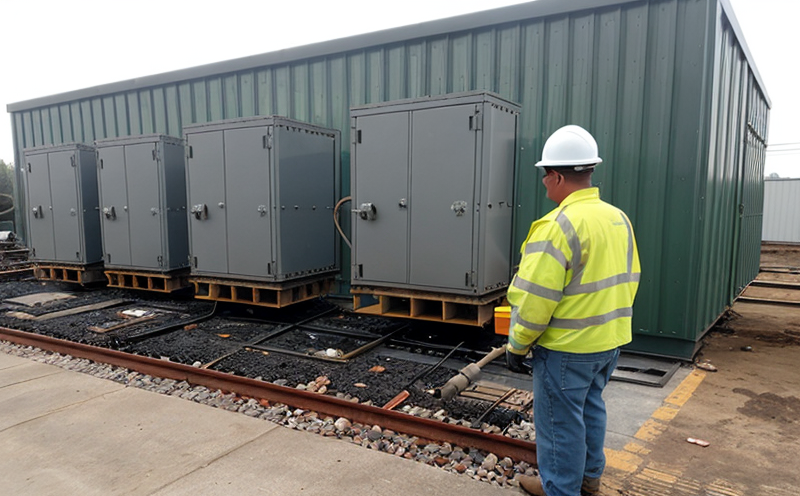Substation transformer inspection
The importance of substation transformers cannot be overstated in the realm of energy systems and environmental surveillance. These transformers serve as critical components that step down high voltage electricity to a lower voltage suitable for distribution. Any failure or malfunction can lead to significant disruptions in power supply, posing risks not only to the reliability of electrical grids but also to public safety.
Regular inspections are essential to ensure these vital assets remain operational and safe. This service involves a comprehensive examination that includes visual inspection, detailed analysis using specialized equipment, and performance testing. The goal is to identify potential issues early on, allowing for preventive maintenance rather than reactive repairs which can be more costly and disruptive.
The inspection process typically begins with a thorough visual assessment of the transformer's physical condition. This includes checking for any signs of corrosion, leaks, or overheating. Following this initial step, non-destructive testing methods such as ultrasonic testing (UT), eddy current testing (ECT), and dielectric testing are employed to detect internal defects that cannot be seen from the outside.
One of the most critical aspects of substation transformer inspection is the evaluation of insulation properties. Poor insulation can lead to arcing, which may cause fires or other severe electrical incidents. Testing for insulation resistance using megger devices helps ensure that insulating materials meet specified standards set by international bodies like IEEE and IEC.
Performance testing forms another crucial part of this service. This involves measuring parameters such as winding resistance, no-load losses, and short-circuit impedance under controlled conditions. These tests help assess whether the transformer is performing within acceptable limits according to its design specifications and applicable standards. By comparing test results against baseline data gathered during previous inspections, any deviations can be pinpointed accurately.
Once all inspections have been completed, detailed reports are generated summarizing findings along with recommendations for necessary actions or follow-up measures. These reports serve as valuable tools not only for immediate decision-making but also as records of the transformer's health over time. They play a vital role in maintaining compliance with local regulations and international standards.
In summary, regular substation transformer inspections are indispensable for safeguarding electrical infrastructure against failures that could disrupt services or compromise safety. Through meticulous examination and testing procedures, this service ensures transformers continue to function optimally throughout their lifecycle.
Why It Matters
The reliability of power supply is paramount for modern society. Substation transformers are integral to ensuring that electricity reaches consumers efficiently and safely. Any malfunctioning or poorly maintained transformer can result in prolonged outages, increased maintenance costs, and even hazardous situations. Thus, the importance of regular inspections cannot be overstated.
- Preventive Maintenance: Identifies potential issues before they escalate into full-blown failures reducing downtime and associated expenses.
- Safety Assurance: Ensures compliance with safety regulations preventing accidents and injuries at substations.
- Cost Efficiency: Extends the useful life of transformers, avoiding premature replacements or costly emergency repairs.
- Environmental Impact: By maintaining optimal performance levels, energy loss is minimized contributing to sustainable practices.
These inspections contribute significantly towards achieving broader goals related to sustainability and resilience within electrical networks. They form part of an overall strategy aimed at enhancing the robustness and reliability of power distribution systems worldwide.
International Acceptance and Recognition
The acceptance and recognition of our substation transformer inspection services extend across multiple countries and regions, reflecting our commitment to adhering strictly to global standards. Our inspections are compliant with international norms such as IEEE C57.130-2008 for ultrasonic testing and IEC 61869-4:2016 regarding eddy current testing.
- United States - IEEE C57.130-2008
- European Union - IEC 61869-4:2016
- China - GB/T 1094.10-2017
- Japan - JIS C 1530:2006
- Australia - AS/NZS 1808.1:2012
Our adherence to these stringent requirements ensures that our inspections are recognized and accepted globally, providing peace of mind for clients operating in diverse international markets.
Environmental and Sustainability Contributions
The focus on sustainability has become increasingly important across all sectors. In the context of substation transformers, our inspection services play a pivotal role in promoting environmental responsibility through several means:
Energy Efficiency: By ensuring transformers operate efficiently, we help reduce energy losses during transmission and distribution. This contributes to lower carbon footprints by minimizing unnecessary electricity consumption.
Resource Conservation: Preventive maintenance recommended based on our inspections can extend the service life of transformers reducing the need for frequent replacements which consume raw materials and resources.
Risk Mitigation: Early detection of potential issues prevents major incidents that could lead to significant environmental impacts such as fires or oil spills from leaking transformers.
Our commitment to sustainability aligns with broader industry trends towards greener practices. Through rigorous inspection processes, we contribute positively to the overall effort in reducing adverse effects on the environment while enhancing operational efficiency and reliability of electrical systems.





